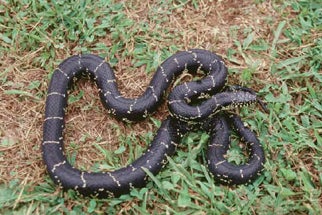SCIENTIFIC NAME:
Lampropeltis getula Linnaeus
OTHER NAMES:
Chain Kingsnake, Common Kingsnake.
STATUS:
Rare to uncommon, and possibly threatened. Found in south-central and eastern portion of Coastal Plain and adjacent Piedmont. Also known from Dauphin Island. Formerly one of Alabama's most commonly encountered snakes but has shown marked declines for reasons not fully understood. HIGH CONSERVATION CONCERN.
DESCRIPTION:
A relatively long (usually 98-122 cm [3-4 ft.], but up to 2.1 m [6.9 ft.] total length), cylindrically bodied, supple snake with a head only slightly wider than the neck. Easily distinguished by smooth, polished, black to dark brown scales on back and sides brightly overlaid with a series of 23 to 52 narrow, cream, or yellow transverse bands. Some bands may be broken and often terminate, or are linked together, on the lower sides. Belly usually checkered or mottled with black and yellow. Juveniles have same color pattern as adults (Krysko 2001). Anal scale undivided and there are 21 or 23 mid-body scale rows. One of three distinct subspecies in Alabama (Mount 1975).
DISTRIBUTION:
Throughout the eastern United States from New Jersey to northern Florida, and confined in southeastern and southern Alabama to Lee, Macon, Russell, Barbour, Henry, Houston, Bullock, Pike, Dale, Coffee, Geneva, Crenshaw, Butler, Covington, Escambia, and Baldwin Counties—and on Dauphin Island in Mobile County (Mount 1975). Intergrades abruptly with other subspecies along distributional boundaries (Means and Krysko 2001).
HABITAT:
Nearly all terrestrial habitats with a relatively open canopy including native longleaf pine forest, annually burned pinelands, fields and meadows, abandoned farms, rural garbage dumps, and margins of ponds and streams. Does not live in closed-canopy pine plantations, dense hardwood forests, or mixed pine-oak-hickory stands with closed canopies. Sometimes found in river floodplains, coastal strands, or on barrier islands (Mount 1975).
LIFE HISTORY AND ECOLOGY:
Where common, frequently encountered during normal daytime activity, which is greatest in mid-morning hours with a second peak in late afternoon. Occasional individuals found active midday and after dark. A terrestrial snake, most often found on the ground but retiring underground in burrows or stump holes day or night and to forage for food (Means 2003b). Rarely climbs, but is a capable swimmer. Food consists of other vertebrates such as frogs, birds, eggs of ground-nesting birds and turtles, rodents, lizards, and other snakes, including venomous snakes. A powerful constrictor, kills prey by suffocating with coils, although some prey, such as frogs and eggs, are eaten alive and without constriction. Courtship and mating take place in spring from March to early May, and three to 29 leathery shelled eggs are laid in early summer (June-July) in soft, moist earth, usually under a log. Eggs hatch in July or August after an incubation period of about 60 days. Sexual maturity probably reached in the third spring after hatching when about 0.9 meter (three feet) long. Predators of adults are hawks, owls, bobcat, black bear, coyote, and humans, but these and more (feral pigs, feral cats and dogs, armadillos, larger kingsnakes) prey on the eggs and young. There is mounting concern that red imported fire ants (Solenopsis spp.) may attack and devour eggs or young as they hatch (Mount 1986).
BASIS FOR STATUS CLASSIFICATION:
The eastern kingsnake and other kingsnakes have declined precipitously throughout their distribution in adjacent Florida in the past two decades, in most cases without an obvious cause (Krysko and Smith 2003). There is evidence that the eastern kingsnake also recently has declined in Alabama, as has apparently the speckled kingsnake (see account) but not the black kingsnake. Agriculture, silviculture, and urbanization are the greatest causes of habitat loss. A fairly conspicuous snake that moves rather slowly, the eastern kingsnake is easily killed or captured. Many Alabamians recognize the species and refrain from killing it, but others believe the only good snake is a dead snake. Its habit of becoming calm and inoffensive if handled gently has made it popular in the pet trade, but how much of an impact this has made on Alabama populations is unknown.
Author:
D. Bruce Means






